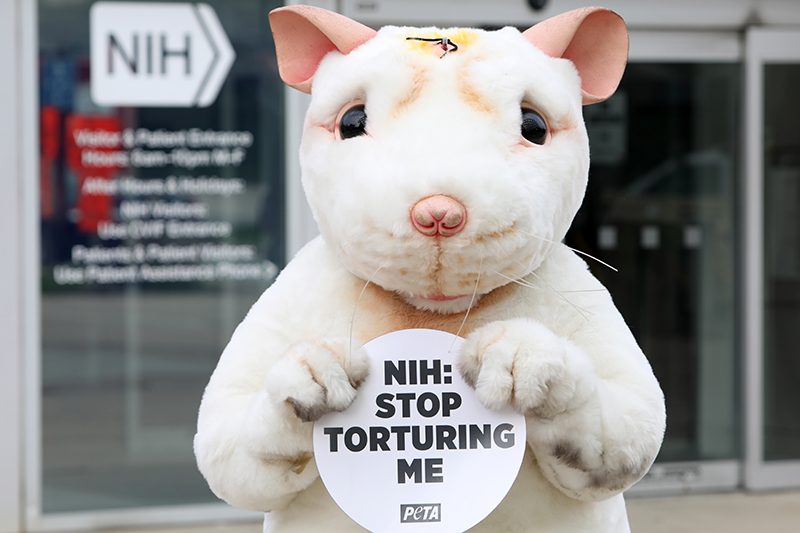UN INT Intro Text w/ Responsive Image - *Important Note* You must UNLINK this shared library component before making page-specific customizations.
It's the stuff of horror movies: The victim is pursued, trapped, and tormented—and driven to nightmarish levels of fear. These scenes play out over and over again in the taxpayer-funded laboratories of the National Institute of Mental Health (NIMH) in Bethesda, Maryland, where untold numbers of mice and rats are used in pathologically cruel psychology experiments designed to induce or measure extreme fear, panic, despair, terror, trauma, and a sense of helplessness in the animals. There's no rescue and no happy ending in store for them.

This “mouse” stood in front of the National Institutes of Health in Washington, D.C., to urge the agency to stop conducting cruel and useless depression tests on mice and other animals.
Here are just a few of the twisted things that animals held captive in these laboratories are subjected to:
Footshock
The experimental practice of electrically shocking animals began in the early 20th century and was popularized by Martin Seligman and Steven Maier, who, in the 1960s, administered painful and unpredictable electric shocks to dogs. The animals became so anxious and depressed that, eventually, they didn't even try to escape when shocked. Seligman and Maier termed this condition "learned helplessness," and a mob of experimenters lined up to perform similar experiments on a veritable Noah's ark of animals. (Seligman's sick experiments also inspired the psychologists who devised the CIA's now-disgraced human-torture program.)
In NIMH’s laboratories, mice are locked inside a chamber with an electrified grid floor. The experimenters deliver electric shocks at unpredictable intervals to the animals' feet, causing stress and possibly pain. The mice jump and scramble around the chamber, often colliding into walls. Some of them freeze, likely terrified to move a muscle after being shocked.
Forced Swim Test
At NIMH, experimenters drop mice in inescapable containers filled with water for the forced swim test. The panicked animals swim—their small hind feet kicking frantically—desperate to keep their heads above water. They circle the beaker, push against the sides, and try to climb up the walls of the container, looking for an escape. In their fear, the animals may defecate or cry out. This goes on for 11 minutes, during which the panicked mice swim to keep from drowning or float—likely to try to conserve their energy.

Tail Suspension Test
In the tail suspension test, experimenters at NIMH suspend mice upside down and tape their sensitive tails to a horizontal bar. The animals struggle to right themselves from this awkward position, but they have no control. Trying their hardest, they attempt to pull their bodies up, holding on for dear life to the tape affixed to their tails—only to drop back down again and resume their exertion. The test continues for six minutes, during which the mice struggle and the experimenters watch—apparently without any compassion.
Cruel and Worthless
In addition to being horrifyingly cruel and unethical, these tests are bad science. The forced swim and tail suspension tests are used to evaluate drugs for antidepressant properties based on the assumption that when an animal stops swimming or struggling, he or she is depressed, and on the belief that animals who have been given antidepressants will swim or struggle for longer. But the data simply don't back up these assumptions.
Footshock experiments are thought to mimic human life stressors. But the stresses experienced by humans—including financial struggles, job dissatisfaction, and familial problems—don't involve the physical stress that being electrically shocked does. Certainly, humans suffering from depression, anxiety, or post-traumatic stress disorder typically don't manifest these conditions as a result of receiving electrical shocks to their feet.
Please tell NIMH to stop tormenting vulnerable animals and to end its use of forced swimming, tail suspension, and footshock by signing our petition below.